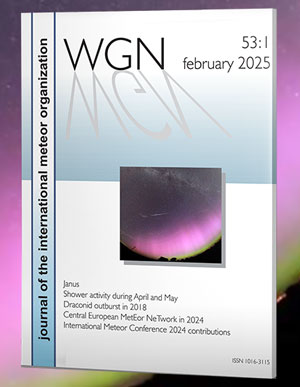
The Geminids in 2024 will be largely spoiled by a bright moon which reaches its full phase on December 15th. The time of maximum activity is predicted to occur anywhere from 17 Universal Time on December 13th to 1 Universal Time on the 14th. This timing favors Asia, but most of the world can see good Geminid activity on December 13 and 14. Since most Geminid meteors are faint, as well as most meteors in general, the intense moonlight will obscure at least 75 percent of the activity normally seen in years without interfering moonlight. This would mean at 2am on either morning the Geminids would produce about 15 meteors per hour.
Observers can avoid moonlight by viewing during the predawn hours after the waxing gibbous moon has set during the week prior to the 13/14 maximum. Hourly rates during this period would be 5-15 per hour, depending on the date. At this time of night the Geminid radiant will lie in the western sky, but Geminid activity can still be seen anywhere in the sky.
Geminid meteors can bee seen all night long from all over the world. Only in Antarctica, where there is 24 hours of daylight this time of year, is this display not visible. The Geminid radiant passes overhead near 2am local standard time for observers located near 30 degrees north latitude. The entire northern hemisphere gets a good view of these meteors. Conditions become less favorable in the southern hemisphere as the radiant is only visible during the morning hours from South Africa, Australia, New Zealand, and the southern portions of South America. The radiant is also located much lower in the northern sky as seen from these southern locations.
Seeing 15 meteors per hour is stronger than most nights of the year, so if your sky is clear the effort to see these meteors is worth it. Photographers may also wish to take advantage of the illuminated landscape and try to capture bright Geminid meteors near the horizon, where they are most numerous.
There are only two more major meteors showers predicted for the “meteor season” in the northern hemisphere. The normally weak Ursids peak on December 22nd with a half-illuminated moon in the morning sky. expected hour rates would only be near 5. The Quadrantids are predicted to peak on January 3rd between 15 and 17 Universal Time which favors Alaska and extreme eastern Russia. Hawaii may be well positioned but the radiant will be much lower in the sky, hence less activity. Since there is no interfering moonlight for the Quadrantids, maximum rates could be quite strong, surpassing 60 per hour for the favored locations. The peak only lasts around 6 hours so most of the world will witness a much weaker display.




 You saw something bright and fast? Like a huge shooting star? Report it: it may be a fireball.
You saw something bright and fast? Like a huge shooting star? Report it: it may be a fireball.  You counted meteors last night? Share your results with us!
You counted meteors last night? Share your results with us!  You took a photo of a meteor or fireball? You have a screenshot of your cam? Share it with us!
You took a photo of a meteor or fireball? You have a screenshot of your cam? Share it with us!  You caught a meteor or fireball on video? Share your video with us!
You caught a meteor or fireball on video? Share your video with us!